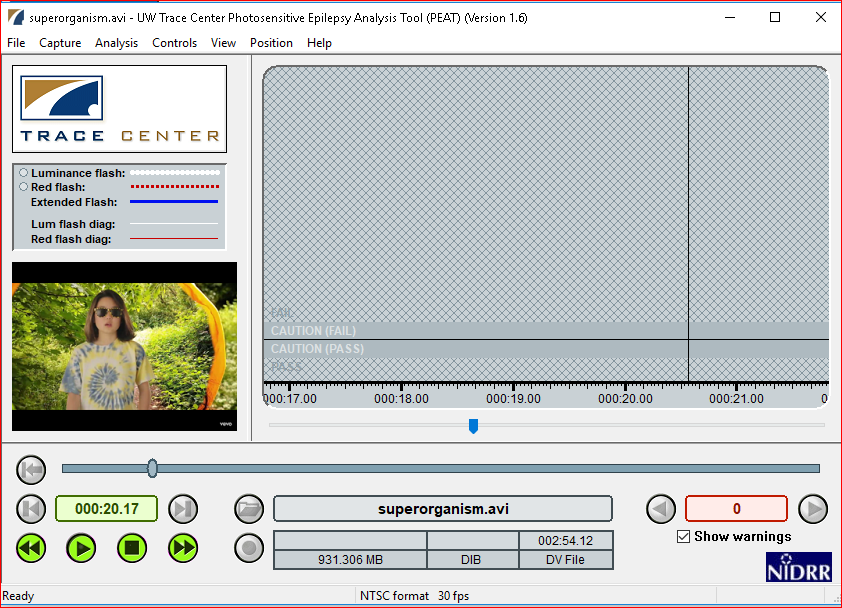Definition for WCAG 2.0 success criterion 2.3.1
2.3.1 Three Flashes or Below Threshold: Web pages do not contain anything that flashes more than three times in any one second period, or the flash is below the general flash and red flash thresholds.
Note: Since any content that does not meet this success criterion can interfere with a user's ability to use the whole page, all content on the Web page (whether it is used to meet other success criteria or not) must meet this success criterion.
The intent of this Success Criterion is to allow users to access the full content of a site without inducing seizures due to photo-sensitivity.
Individuals who have photosensitive seizure disorders can have a seizure triggered by content that flashes at certain frequencies for more than a few flashes. People are even more sensitive to red flashing than to other colors, so a special test is provided for saturated red flashing.
Flashing can be caused by the display, the computer rendering the image or by the content being rendered. The author has no control of the first two. The intent of this criterion is to ensure that flicker that violates the flash thresholds is not caused by the content itself. For example, the content could contain a video clip or animated image of a series of strobe flashes, close-ups of rapid-fire explosions, or fast color changes.
The general term "blinking" refers to content that causes a distraction problem. Blinking can be allowed for a short time as long as it stops (or can be stopped). However, this success criterion deals with "flashing", which refers to content that can trigger a seizure (if it is more than 3 per second and large and bright enough). This cannot be allowed even for a second or it could cause a seizure. And having a mechanism to turn the flash off is also not an option since the seizure could occur faster than most users could turn it off.
Note: if the page contains no flashing content, or if the flashes occur at a frequency below 3 flashes per second (3Hz), this criterion is marked as pass.
Note: in general, the safest assumption for content authors is to avoid all forms of flashing content, or to keep flashing frequency below 3 flashes per second (3Hz). This makes a pass/fail determination at testing time significantly easier. However, if content must flash, and it must flash at a frequency higher than 3Hz, content authors need to very accurately determine the safe threshold they can use, and testers must more accurately analyze the page to determine if the flashing is deemed safe according to WCAG 2.0.
The safe threshold for flashing content (i.e., content passes and the criterion can be marked as pass) is:
- There are no more than three flashes within any one-second period (a flash frequency lower than 3Hz); OR
- The combined area of flashes occurring concurrently occupies no more than a total of ".006 steradians within any 10 degree visual field on the screen (25% of any 10 degree visual field on the screen) at typical viewing distance". For general software or Web content, using a 341 x 256 pixel rectangle anywhere on the displayed screen area when the content is viewed at 1024 x 768 pixels will provide a good estimate of a 10 degree visual field for standard screen sizes and viewing distances (e.g., 15-17 inch screen at 22-26 inches). As such, there must be no areas of approximately 341 x 256 pixels where more than 25% of the area flashes.
The term "flash" includes both "general flash" and "red flash". General flash is defined as a pair of opposing changes in relative luminance of 10% or more of the maximum relative luminance where the relative luminance of the darker image is below 0.80; and where "a pair of opposing changes" is an increase followed by a decrease, or a decrease followed by an increase. A red flash is defined as any pair of opposing transitions involving a saturated red. The current working definition in the field for "pair of opposing transitions involving a saturated red" is where, for either or both states involved in each transition, R/(R+ G + B) >= 0.8, and the change in the value of (R-G-B)x320 > 20 (negative values of (R-G-B)x320 are set to 0) for both transitions. R, G, B values range from 0-1.
Testing success criterion 2.3.1
Input into spreadsheet
- Fail
- The page contains elements that flash at a frequency higher than 3 flashes per second (3Hz) and the flashing exceeds the safe threshold for general flash and red flash.
- Pass
-
- The page contains no flashing elements.
- Elements that flash do so at a frequency no higher than 3 flashes per second (3Hz).
- Elements that flash at a frequency higher than 3Hz are below the safe threshold for general flash and red flash.
How to test
- Verify if the page contains any elements that flash
- Observe the flashing elements and determine if the flash frequency is higher than 3Hz. This can be done with a reasonable degree of confidence without any tools by counting out seconds "ONE and ah TWO and ah THREE and ah...", which equates to 3 vocalizations a second, and ascertaining if the content flashes more frequently than those vocalizations.
- If the flash frequency is higher than 3 flashes per second, refer to additional testing procedures outlined in Techniques for WCAG 2.0 - G15: Using a tool to ensure that content does not violate the general flash threshold or red flash threshold - in particular, the use of Trace Center's Photosensitive Epilepsy Analysis Tool (PEAT) (Windows only).
The following screenshot shows the Trace Center's Photosensitive Epilepsy Analysis Tool being used to analyze a video for flashing frequency.
